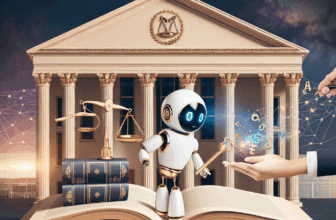Bridging the Gap: Addressing Discrepancies in Asset Disclosures and the Transformative Role of AI in UK Probate
Table of Contents
- 1. Introduction
- 2. Understanding Probate in the UK
- 3. Discrepancies in Asset Disclosures
- 3.1 Causes of Discrepancies
- 4. The Role of AI in Addressing Discrepancies
- 4.1 Automation of Processes
- 5. Real-life Applications of AI in Probate
- 6. Challenges of Implementing AI in Probate
- 7. Future Trends in Asset Disclosure and AI
- 8. Conclusion and Key Takeaways
- FAQ
- Resources
- Application for Grant of Representation: A legal document required to deal with a deceased person's estate.
- Asset Valuation: Identifying and valuing all assets including property, bank accounts, and investments.
- Tax Liabilities: Calculating any applicable Inheritance Tax (IHT) liabilities.
- Distribution of Assets: Once debts have been settled and taxes paid, the remaining assets can be distributed to beneficiaries.
- Incomplete Records: Families may not have complete access to the deceased’s financial records.
- Valuation Disputes: Different valuations for similar assets can arise due to subjective interpretations.
- Hidden Assets: Assets may be unknown to heirs, leading to their exclusion from the probate process.
- Lack of Communication: Between family members or between the executor and beneficiaries.
- Fraud and Misrepresentation: Intentional hiding or misrepresentation of assets can severely complicate the process.
- Inadequate Knowledge: Executors may lack knowledge about specific asset types, leading to misreporting.
- Legal Repercussions: Executors may face legal action if they fail to act in accordance with their fiduciary responsibilities.
- Financial Penalties: The discovery of undisclosed assets may result in back taxes and penalties.
- Family Disputes: Discrepancies may cause distrust and disputes among family members, prolonging the probate process.
- Document Management: AI systems can organize and categorize documents, facilitating easy access and review for executors.
- Efficiency in Valuations: Algorithms can quickly provide estimates of asset values based on historical data and market trends.
- Data Entry Automation: Reducing manual input lowers the risk of human errors in the documentation process.
- Real-time Data Access: AI can provide real-time access to financial databases, ensuring that all assets are accounted for.
- Identifying Anomalies: Machine learning algorithms can detect inconsistencies by comparing reported assets against database information.
- Predictive Insights: AI systems can analyze historical disclosure trends and provide insights for more accurate future disclosures.
- Data Privacy: The use of sensitive personal data in AI processes must comply with regulations such as GDPR.
- Transparency: Stakeholders must understand how AI algorithms work, particularly when they impact decisions regarding asset disclosures.
- Accountability: Establishing who is accountable for AI-driven decisions is crucial for maintaining legal integrity.
- Cultural Factors: Traditional methods are deeply entrenched, and many individuals may be reluctant to adopt new technologies.
- Training Requirements: Implementing AI systems necessitates training for all staff members, which can be time-consuming and expensive.
- Fear of the Unknown: Stakeholders may fear that AI could undermine human judgment in sensitive matters like estate management.
- The probate process is complex and fraught with challenges regarding asset disclosures.
- Discrepancies arise from multiple sources, including incomplete records and intentional misrepresentations.
- AI can provide significant benefits, from automating processes to enhancing data analysis.
- Despite its potential, AI adoption faces legal, ethical, and cultural challenges that must be addressed.
- The future holds exciting possibilities, including predictive analytics and blockchain integration for more effective asset disclosures.
- What is probate?
Probate is the legal process of administering the estate of a deceased person, which includes identifying assets, paying creditors, and distributing the remaining assets to beneficiaries. - What are common discrepancies in asset disclosures?
Common discrepancies can include incomplete records, valuation disputes, and hidden assets that were not disclosed during the probate process. - How can AI help with asset disclosures?
AI can automate processes, enhance data analysis, and provide real-time access to financial records, making asset disclosures more accurate and efficient. - Are there any ethical concerns with using AI in probate?
Yes, concerns include data privacy, transparency of algorithms, and accountability for decisions made by AI.
1. Introduction
The field of probate is often fraught with complexities that arise from discrepancies in asset disclosures. In the UK, dealing with a deceased person's estate involves various legal and financial considerations, making accurate reporting and transparency essential. With the advent of Artificial Intelligence (AI), the landscape of asset disclosures is changing rapidly. This article examines how AI can bridge discrepancies in asset disclosures during probate by streamlining processes, enhancing accuracy, and ultimately creating a more efficient probate system for all parties involved.
2. Understanding Probate in the UK
2.1 The Probate Process
The probate process involves several steps, beginning with the identification of the deceased's assets and liabilities. It includes the following key steps:
2.2 Common Challenges in Asset Disclosure
Accurate asset disclosure is crucial during the probate process, as discrepancies can lead to delays, legal disputes, or even tax implications. Common challenges include:
3. Discrepancies in Asset Disclosures
3.1 Causes of Discrepancies
Discrepancies in asset disclosures can arise from a variety of factors:
3.2 Consequences of Discrepancies
Failure to accurately disclose assets can lead to a range of consequences:
4. The Role of AI in Addressing Discrepancies
4.1 Automation of Processes
AI can streamline numerous aspects of the probate process by automating repetitive tasks:
4.2 Data Analysis and Validation
AI can enhance the validation and analysis of asset disclosures significantly:
5. Real-life Applications of AI in Probate
5.1 Case Study: Use of AI in Asset Valuation
One notable application of AI in asset valuation is through a platform developed by a UK-based fintech company. This platform uses sophisticated algorithms to analyze market data and historical pricing, providing a reliable valuation of various asset classes. Executors can input details about the assets, and the platform swiftly generates a valuation report, reducing the time and potential discrepancies often associated with manual valuations.
5.2 Case Study: AI in Fraud Detection
An innovative application of AI in the probate field was demonstrated by a law firm that integrated machine learning into their asset verification process. The AI system cross-referenced submitted asset lists against public records and databases, flagging notable discrepancies for further investigation. This technology helped to uncover previously hidden assets, ensuring that the probate process upheld legal and ethical standards while maintaining transparency among stakeholders.
6. Challenges of Implementing AI in Probate
6.1 Legal and Ethical Considerations
While AI holds great promise for transforming probate processes, there are significant legal and ethical challenges that must be addressed:
6.2 Resistance to Change
Another barrier to implementing AI in the probate sector lies in the resistance to technological change:
7. Future Trends in Asset Disclosure and AI
7.1 Predictive Analytics
One emerging trend is the use of predictive analytics to improve asset disclosure accuracy. By analyzing historical data, AI systems can provide insights on potential discrepancies, allowing executors to address them before formal submissions. Predictive tools can be particularly valuable in forecasting fluctuations in asset values, helping executors plan effectively for tax liabilities.
7.2 Integration with Blockchain
Another exciting development on the horizon is the integration of AI with blockchain technology. Blockchain can provide an immutable, transparent record of asset ownership, while AI can analyze this data in real-time, ensuring that all disclosures are accurate and up-to-date. This combination could enhance trust and efficiency in the probate process, benefitting executors, beneficiaries, and regulators alike.
8. Conclusion and Key Takeaways
The integration of AI into the UK probate system presents transformative opportunities to address discrepancies in asset disclosures, enhancing the accuracy, efficiency, and transparency of processes. By automating tasks, analyzing data more effectively, and offering real-time insights, AI can bridge the existing gaps in asset disclosures.
Key takeaways from this exploration include:
Further study and investment in AI technologies are essential to fully leverage its potential in the UK probate sector, ultimately resulting in a more streamlined, trustworthy, and efficient system of managing deceased estates.
FAQ
Resources
| Source | Description | Link |
|---|---|---|
| UK Government Probate Information | Official government resources on the probate process and regulations. | gov.uk |
| Law Society of England and Wales | Guidance on legal considerations related to probate and estate administration. | lawsociety.org.uk |
| Artificial Intelligence in Law: The Future | Research document discussing the implications of AI in legal contexts. | legalfutures.co.uk |
| Inheritance Tax Planning | A guide covering the financial aspects related to inheritance and probate. | gov.uk |
| AI and Data Privacy Regulations | Explains the intersection of AI technology and privacy law in various sectors. | ico.org.uk |
Disclaimer: This article is generated by an AI model and is currently in Beta Testing. The information provided is for educational purposes only and should not be considered legal or financial advice. Always consult a qualified professional for specific guidance concerning probate and asset disclosures.










